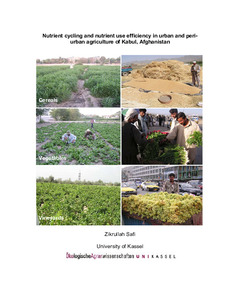| dc.date.accessioned | 2011-05-31T07:52:06Z | |
| dc.date.available | 2011-05-31T07:52:06Z | |
| dc.date.issued | 2011-05-31T07:52:06Z | |
| dc.identifier.uri | urn:nbn:de:hebis:34-2011053137638 | |
| dc.identifier.uri | http://hdl.handle.net/123456789/2011053137638 | |
| dc.language.iso | eng | |
| dc.rights | Urheberrechtlich geschützt | |
| dc.rights.uri | https://rightsstatements.org/page/InC/1.0/ | |
| dc.subject | Nutrient cycling | eng |
| dc.subject | Kabul, Afghanistan | eng |
| dc.subject | Urban agriculture | eng |
| dc.subject | Peri-urban agriculture | eng |
| dc.subject.ddc | 630 | |
| dc.title | Nutrient cycling and nutrient use efficiency in urban and peri-urban agriculture of Kabul, Afghanistan | eng |
| dc.type | Dissertation | |
| dcterms.abstract | Like elsewhere also in Kabul, Afghanistan urban and peri-urban agriculture (UPA) has often been accused of being resource inefficient and unsustainable causing negatives externalities to community health and to the surroundings. These arise from the inappropriate management and use of agricultural inputs, including often pesticides and inter-city wastes containing heavy metal residues and pathogens. To address these concerns, parallel studies with the aims of quantification of carbon (C), nitrogen (N), phosphorus (P) and potassium (K) horizontal and vertical fluxes; the assessment of heavy metal and pathogen contaminations of UPA produce, and an economic analysis of cereal, vegetable and grape production systems conducted for two years in UPA of Kabul from April 2008 to October 2009. The results of the studies from these three UPA diverse production systems can be abridged as follows:
Biennial net balances in vegetable production systems were positive for N (80 kg ha-1 ), P (75 kg ha-1) and C (3,927 kg ha-1), negative for K (-205 kg ha-1), whereas in cereal production systems biennial horizontal balances were positive for P (20 kg ha-1 ) and C (4,900 kg ha-1) negative for N (-155 kg ha-1) and K (-355 kg ha-1) and in vineyards corresponding values were highly positive for N (295 kg ha-1), P (235 kg ha-1), C (3,362 kg ha-1) and slightly positive for K (5 kg ha-1). Regardless of N and C gaseous emissions, yearly leaching losses of N and P in selected vegetable gardens varied from 70 - 205 kg N ha-1 and 5 - 10 kg P ha-1. Manure and irrigation water contributed on average 12 - 79% to total Inputs of N, P, K and C, 10 - 53% to total inputs of C in the gardens and fields.
The elevated levels of heavy metal and pathogen loads on fresh UPA vegetables reflected contamination from increasing traffic in the city, deposits of the past decades of war, lacking collection and treatment of raw inter-city wastes which call for solutions to protect consumer and producer health and increase reliability of UPA productions.
A cost-revenue analysis of all inputs and outputs of cereal, vegetable and grapes production systems over two years showed substantial differences in net UPA household income. To confirm these results, more detailed studies are needed, but tailoring and managing the optimal application of inputs to crop needs will significantly enhance farmer’s better revenues as will as environmental and produce quality. | eng |
| dcterms.accessRights | open access | |
| dcterms.creator | Safi, Zikrullah | |
| dc.contributor.corporatename | Kassel, Universität, FB 11, Ökologische Agarwissenschaften | |
| dc.contributor.referee | Bürkert, Andreas (Prof. Dr.) | |
| dc.contributor.referee | Schlecht, Eva (Prof. Dr.) | |
| dc.subject.swd | Kabul | ger |
| dc.subject.swd | Stadtnahe Landwirtschaft | ger |
| dc.subject.swd | Städtische Landwirtschaft | ger |
| dc.date.examination | 2011-05-03 | |

